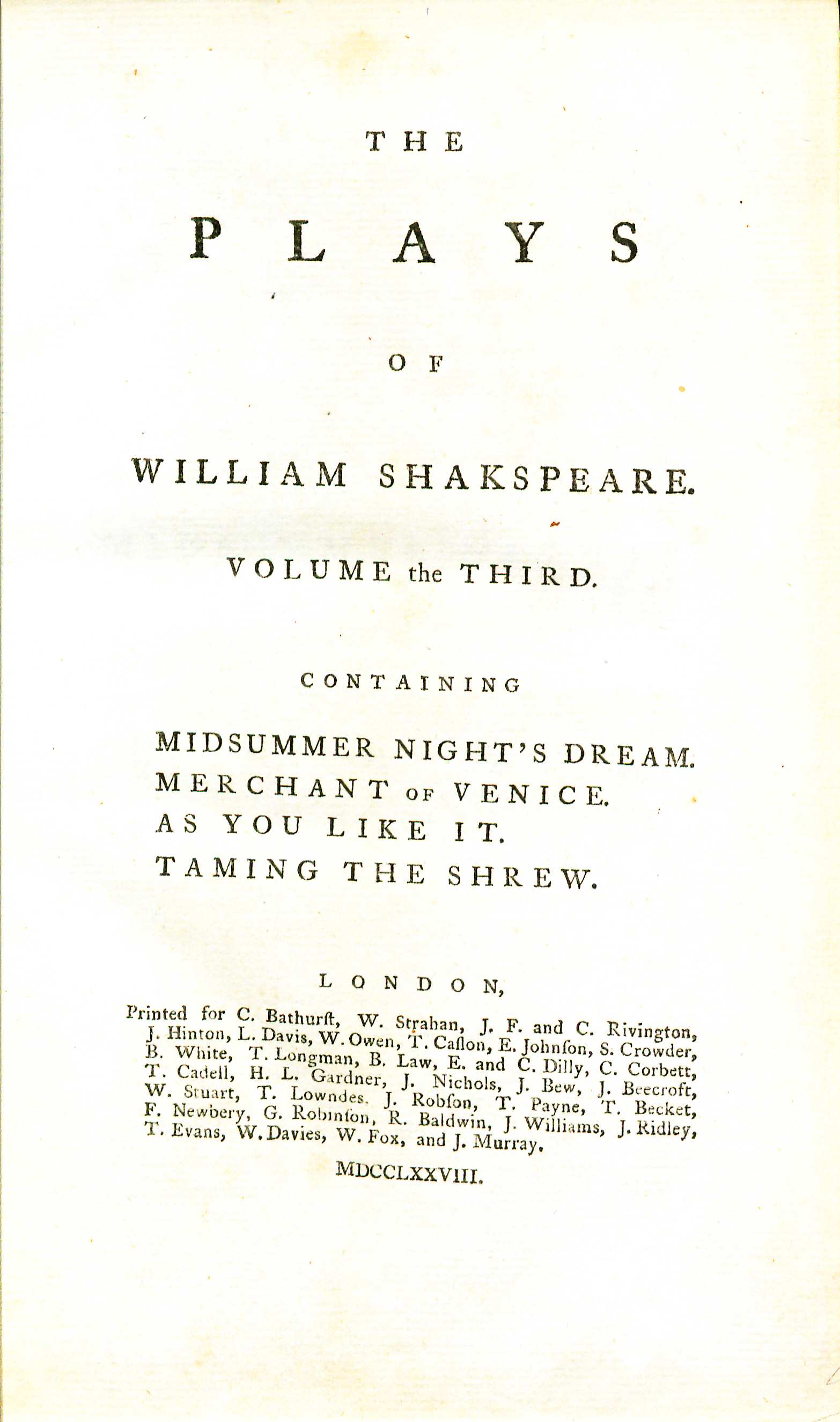The Plays of William Shakespeare
The Plays of William Shakespeare: in Ten Volumes, with the Corrections and Illustrations of Various Commentators to Which are Added Notes
by William Shakespeare
| The Plays of William Shakespeare | |
|
Title page from The Plays of William Shakespeare, volume three, George Wythe Collection, Wolf Law Library, College of William & Mary. | |
| Author | William Shakespeare |
| Published | London: Printed for C. Bathurst et al. |
| Date | 1778 |
| Language | English |
| Volumes | 10 volume set |
| Desc. | 8 vo (23 cm.) |
William Shakespeare (1564-1616) is a playwright and poet widely seen as the foremost writer in the English language.[1]
Shakespeare was an actor that begun to write plays sometime between 1585 and 1592. He began his career as a playwright with English histories, including Henry VI, comedies, including The Taming of the Shrew, and tragedies, including Titus Andronicus.[2] His first published work was the poem Venus and Adonis (1593).
His plays were beginning to be published in 1594, during which time he wrote Love’s Labour’s Lost, Richard II, Romeo and Juliet, and A Midsummer Night’s Dream. He continued to write prolifically during the late 1590s and 1600s. In 1606 Shakespeare wrote King Lear and Macbeth, which are both influenced by contemporary politics.
In 1609, Thomas Thorpe famously published Shakespeare’s sonnets, provoking controversy to this day about the rationale behind the order of the sonnets,[3] and the identity of “W.H.” that Thorpe included in his epigraph.[4] By 1609, about half of Shakespeare’s plays had been printed. Shakespeare continued to write plays until 1613, and he died in 1616.
Shakespeare is known for his exploration of human nature, as Samuel Johnson states in his famous “Preface to the Works of Shakespeare”:
His persons act and speak by the influence of those general passions and principles by which all minds are agitated, and the whole system of life is continued in motion. . . .Shakespeare has no heroes; his scenes are occupied only by men, who act and speak as the reader things that he himself should have spoken and acted on the same occasion.[5]
The first folio of Shakespeare’s work was published in 1623, and was expanded and revised countless times in the next century. Editions of the collected works of Shakespeare accumulated notes of different editors and biographical details that cumulate with The Plays of William Shakespeare: In Ten Volumes. This folio edition only includes Shakespeare’s plays.
Evidence for Inclusion in Wythe's Library
Description of the Wolf Law Library's copy
All volumes uniformly bound in tree calf leather with ornate gilt border to upper and lower boards and gilt turn ins. Three contemporary gilt bordered black leather labels to spines with marbled endpapers. Set includes two volume Supplement edited by Samuel Johnson and George Steevens (London: C. Bathurst [etc.], 1780). Purchased from Weybridge Books.
View this book in William & Mary's online catalog.
External Links
References
- ↑ Peter Holland, “Shakespeare, William (1564–1616)”, Oxford Dictionary of National Biography (Oxford University Press, 2004), accessed October 7, 2013. Unless otherwise noted, all biographical details are from this source.
- ↑ S. Schoenbaum, “William Shakespeare, Gentleman,” The Wilson Quarterly (1976-), 3, No. 1 (Wilson Quarterly, 1979), p. 184.
- ↑ J.A. Fort, “The Order and Chronology of Shakespeare’s Sonnets,” The Review of English Studies, 9, No. 33 (Oxford University Press, 1933), p. 22.
- ↑ Donald W. Foster, “Master W.H., R. I. P.,” PMLA, 102, No. 1 (Modern Language Association, Jan. 1979), p. 42.
- ↑ Samuel Johnson, “Preface,” The Plays of William Shakespeare, accessed through Shakespeare’s Editors (Palomar 2009), vii and xii.
